Want to find the best platform to sell online courses in 2025? The market is booming right in front of us. The online course industry will reach $1 trillion per year by 2030 , while online learning is set to hit $279 billion by 2029 .
These numbers tell only part of the story. Course creators make six or seven-figure yearly earnings . A perfect example is Chloe, who made over $300,000 in her first year using an all-in-one platform to teach financial literacy . Platforms like Udemy now host over 73 million students and 75,000 instructors , making it easier than ever to build a thriving course business.
Picking the right platform can be tricky. Each platform offers unique features, pricing plans, and technical specs that could make your course business succeed or fail. We tested and compared the 9 best platforms to sell online courses in 2025 to give you a clear picture of what really works.
Social media algorithms and complex marketing funnels can be frustrating. Solutions like Rupa Pro make everything simpler – from creating courses with your existing content to automating your marketing. Let’s take a closer look at platforms that can turn your expertise into steady income.
Kajabi

Image Source: Kajabi
Kajabi has helped over 75 million customers launch more than 100,000 businesses in knowledge commerce sectors of all sizes [1]. This platform goes beyond simple course hosting. It serves as a complete business solution where creators can build their entire digital empire.
Kajabi key features
Kajabi gives you an all-in-one platform that removes the need for multiple tools or complex integrations. The platform has:
- Course Creation Tools: Build anything from mini-courses to signature programs with customizable templates and easy-to-use design tools [1]
- Marketing Suite: Email automation, sales funnels, and landing page builders that work naturally together [2]
- Website Builder: Create fully integrated websites in just a few clicks, no coding required [3]
- Community Management: Build private communities where students connect and boost their learning experience [2]
- Analytics Dashboard: Track performance with metrics shown in applicable reports [3]
The platform also has AI-powered tools that help sort material, suggest optimal structures, and generate content ideas to speed up your course creation process [1]. Students and creators can manage and access courses on their mobile devices [1].
Kajabi pros and cons
Pros:
- You keep what you earn with zero transaction fees on all plans [4]
- One platform houses everything—no need to piece together multiple tools [5]
- Built-in video hosting without external services [5]
- Strong automation features for marketing and student experiences [5]
- Multiple payment options with subscription model support [5]
Cons:
- Starting price runs higher than competitors [5]
- More features mean more time to learn the platform [5]
- Checkout page customization options are limited [5]
- Webinar hosting requires third-party tools [5]
- Team teaching needs separate instructor accounts [5]
Creators who want a simpler solution might think over Rupa Pro. Its AI Product Generator turns your existing content into course outlines without technical complexity.
Kajabi pricing
The platform offers four main pricing tiers with monthly or annual billing options (20% discount for annual plans) [5]:
- Kickstarter: $89/month ($71/month annually) – 1 product, 250 contacts, 7,500 emails [4]
- Basic: $149/month ($119/month annually) – 3 products, 10,000 contacts, unlimited emails [4]
- Growth: $199/month ($159/month annually) – 15 products, 25,000 contacts, affiliate program [4]
- Pro: $399/month ($319/month annually) – 100 products, 100,000 contacts, 3 websites [4]
Every plan comes with Kajabi AI, the Creator Studio, and zero transaction fees—though standard payment processing fees apply [1].
Kajabi best for
We designed Kajabi for content creators and knowledge entrepreneurs who need powerful marketing tools and robust course delivery. It works especially well for:
- Coaches and consultants who sell high-ticket courses or memberships
- Creators ready to move beyond simple course platforms
- Businesses that need advanced marketing automation
- People who want one system instead of multiple platforms
New creators with tight budgets or those who prefer simplicity might find Rupa’s automated marketing approach more available. It handles checkout, emails, and strategy automatically without complex funnels.
Thinkific
Image Source: Thinkific
Thinkific helps course creators with a flexible learning management system that serves over 35,000 customers in more than 100 countries and businesses of all sizes [1]. Course creators have earned $3.70 billion through the platform and reached 214 million learners worldwide since the company started [2].
Thinkific key features
Thinkific gives you a strong set of tools to create professional learning experiences:
- Drag-and-drop course builder that needs no coding skills and supports many content formats like videos, quizzes, PDFs, and notes [5]
- Built-in website and landing page builder with customizable templates and SEO optimization [5]
- TCommerce selling solution with abandoned cart recovery, gifting options, and flexible payment methods [2]
- Student engagement tools such as quizzes, certificates, and discussion areas [5]
- AI-powered assistance for content generation, course outlines, and landing page creation [5]
The platform stands out with unlimited courses and simple content import options. The analytics dashboard shows you detailed data about student progress, revenue trends, and completion rates [5].
Thinkific pros and cons
Pros:
- Very easy-to-use interface that you can learn quickly [5]
- No transaction fees on any plan (only standard payment processing fees apply) [2]
- Grows smoothly with your business [1]
- Great customer support through multiple channels [5]
- Complete integrations with marketing tools like GetResponse and Zapier [5]
Cons:
- Content protection issues (paid subscribers can access course content URLs through “View HTML”) [5]
- Technical problems including sudden account suspensions [5]
- Videos take long to upload (some users wait 30-60 minutes per video) [5]
- Free plan ends in 2025 [5]
- Problems closing accounts and unexpected charges after trying to cancel [5]
Newer platforms like Rupa Pro offer simpler options with automatic marketing systems and AI product generation that solve many of these technical issues.
Thinkific pricing
Thinkific offers four pricing tiers (billed monthly or annually with savings) [2]:
- Basic Plan: $36/month (annual) or $49/month – Has unlimited courses, one community, abandoned cart recovery, and essential selling tools
- Start Plan: $74/month (annual) or $99/month – Adds unlimited live lessons, memberships, digital downloads, and HTML/CSS editing
- Grow Plan: $149/month (annual) or $199/month – Has three communities, Thinkific Analytics, group orders, and no Thinkific branding
- Thinkific Plus: Custom pricing – Enterprise-level features with CRM integrations, single sign-on, and dedicated onboarding
Thinkific best for
Thinkific works best for educators who want an easy-to-use platform with strong customization options. The platform fits perfectly for:
- Small-to-medium sized course creators ready to move beyond simple platforms
- Businesses that need full control over their learning environment
- Educators who prefer focusing on content instead of technical details
- Organizations that need detailed analytics and student progress tracking
Creators who find technical aspects overwhelming might prefer alternatives like Rupa. Thinkific lets you customize everything, but Rupa’s AI Product Generator can quickly turn your existing content into course outlines without any technical hassle.
Podia
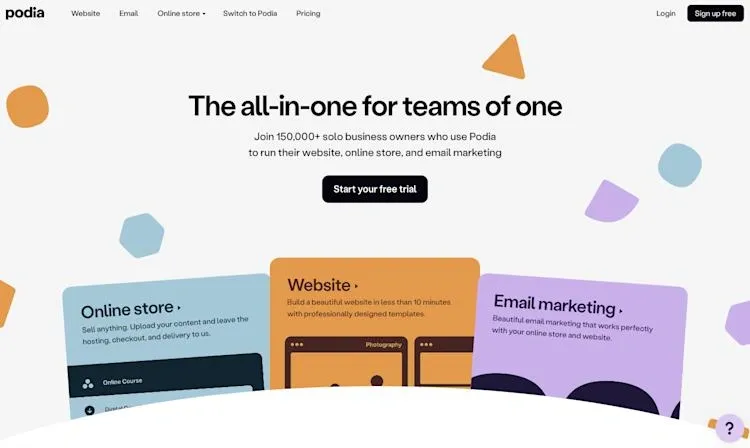
Image Source: Podia
Podia stands out as a clean, creator-friendly platform that brings together the tools you need to sell digital products without getting lost in technical details. More than 150,000 solo business owners rely on this all-in-one solution to run their digital product businesses [4].
Podia key features
Podia gives you a complete set of tools that make selling digital products simple:
- Versatile product selling: Sell online courses, digital downloads, memberships, webinars, coaching sessions, and bundled products from a single dashboard [4]
- User-friendly course builder: Build unlimited courses with videos, quizzes, certificates, and drip content without technical know-how [6]
- Website and blog creation: Create a full website with unlimited pages, sales pages, and an integrated blog that brings in organic traffic [4]
- Community building: Build and monetize communities where members connect, share ideas, and stay engaged with your content [3]
- Built-in email marketing: Use email automation, campaigns, and newsletters with your first 100 subscribers at no cost [7]
- Checkout experience: Your customers can buy directly from your site without creating accounts [8]
A standout benefit is Podia’s unlimited video hosting on every plan, so you won’t need external hosting services [3]. The platform takes care of all technical aspects of selling, letting creators focus on making great content instead of managing websites.
Podia pros and cons
Pros:
- A user-friendly platform that’s quick to learn [3]
- No transaction fees on the Shaker plan [7]
- One solution that replaces multiple tool subscriptions [4]
- Support for almost any digital product format [4]
- Great value for the features you get [4]
- Responsive customer support available 7 days a week [3]
Cons:
- Customization options don’t match platforms like Shopify [4]
- No mobile app to manage on the go [4]
- You can’t sell physical products [4]
- 5% transaction fee comes with the Mover plan [7]
- Some advanced features like detailed email workflows are missing [4]
Rupa Pro brings something different to the table with its AI Product Generator that turns existing content into course outlines – a feature that could help with course structure where Podia falls short.
Podia pricing
Podia keeps pricing simple with two plans [7]:
Mover: $39/month ($33/month annually) with 5% transaction fees
- Your website, online store, email marketing, unlimited products, custom domain
Shaker: $89/month ($75/month annually) with no transaction fees
- Everything in Mover plus affiliate marketing, PayPal integration, embedded checkout
Both plans come with Podia Email free for up to 100 subscribers. Extra subscriber packages start at $7/month [7].
Podia best for
Podia works best for:
- Solo creators and small businesses who want simplicity over complex features
- Digital product sellers looking for an integrated solution without technical headaches
- Content creators ready to broaden their revenue beyond courses
- Educators who prefer clean, distraction-free learning spaces
Many creators find that Podia hits the sweet spot between features and ease of use. But if you need automated marketing, Rupa’s built-in systems might work better to eliminate funnel creation and make course launches simpler.
Mighty Networks
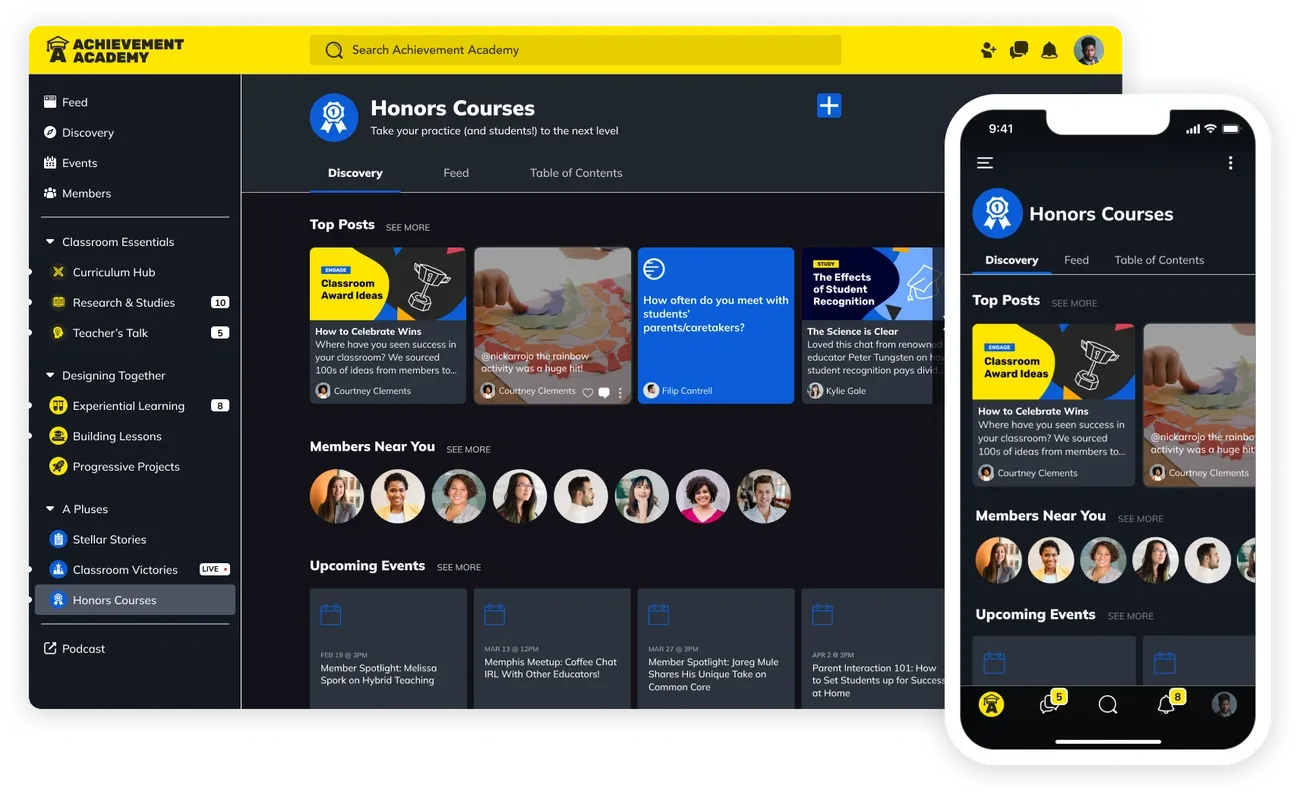
Image Source: Mighty Networks
Mighty Networks stands out as a cultural software platform that puts community building first in the online course space. The platform shows impressive results with a retention rate of 90%. About 65% of members pick annual subscriptions [9]. The team focuses on getting people involved before selling courses.
Mighty Networks key features
The platform delivers a reliable community-focused experience with these notable features:
- Dynamic member connections through profiles, member matching, and location-based tools that show what users have in common [10]
- Engagement tools with points, recognitions, streaks, badges, and an “infinite question engine” that runs on its own [10]
- Flexible space creation that brings together chats, feeds, resource libraries, and events [5]
- Built-in monetization for courses, memberships, and events you can charge for once or through subscriptions [10]
- AI-powered assistance with an AI Cohost that knows community strategy and creates content using GPT-4o [10]
You can also run live streams with multiple speakers and add 2,000+ app embeds to bring outside content into your community [9].
Mighty Networks pros and cons
Pros:
- Great community-building tools with game-like features [11]
- Multiple ways to make money through courses, memberships, and events [11]
- Live streaming built right in – no extra tools needed [12]
- Member referral program to help your community grow [10]
- No caps on members, hosts, or moderators in any plan [13]
Cons:
- Takes time to learn because of its complex interface [12]
- You pay transaction fees on all plans (1-3%) [10]
- Course features aren’t as advanced as specialized platforms [11]
- Missing advanced tools for assignments [13]
- Limited options to customize the design [13]
Mighty Networks pricing
The platform comes with four clear pricing options [10]:
- Community Plan: $49/month ($33/month annually) with 3% transaction fees
- Courses Plan: $119/month ($99/month annually) with 2% transaction fees
- Business Plan: $219/month with 2% transaction fees
- Mighty Pro: Custom pricing with branded mobile apps
Storage space ranges from 250GB to 3TB based on your plan. Live streaming time varies from 5 to 40 hours each month [10].
Mighty Networks best for
This platform shines for creators who value community over complex courses. It works great for:
- Community builders who want deeper connections than regular social media
- Membership site owners looking to build lasting relationships
- Creators who have an audience ready for their own space
- Businesses that need good engagement tools with simple course features
The platform works best when community drives your strategy. Creators who want an easier way to make courses might prefer Rupa Pro. Its AI Product Generator turns your content into course outlines without any technical hassle.
LearnWorlds

Image Source: LearnWorlds
LearnWorlds stands out as an interactive course platform that puts student participation first through innovative learning tools. Trusted by 11,000+ customers worldwide [14], this lightweight learning management system creates immersive educational experiences.
LearnWorlds key features
LearnWorlds’ strong interactive capabilities make it unique:
- Interactive video engine that changes passive watching into active learning with embedded quizzes, subtitles, and AI-powered enhancements [2]
- Assessment tools with exams, quizzes, and certificates plus 50+ reporting options to track learner progress [15]
- Social learning environment with built-in networking, private groups, and community spaces where students interact [16]
- Content creation tools including an ebook builder, course player customization, and AI-assisted course planning [15]
- SCORM/HTML5 compatibility lets you upload existing training materials without reformatting [17]
The platform combines course creation and selling tools in one ecosystem. A built-in mobile app builder requires no coding knowledge [15].
LearnWorlds pros and cons
Pros:
- Leading interactive video features not found on other platforms [17]
- Detailed assessment and exam tools perfect for formal or certified learning [1]
- Economical SCORM hosting (up to 20 files for $99/month) compared to enterprise solutions [17]
- White-label options on all plans give complete branding control [15]
- AI-powered features streamline course creation and video enhancement [15]
Cons:
- New users might find the text-heavy interface challenging [1]
- Marketing tools lag behind platforms like Kajabi [1]
- Entry-level plan includes transaction fees [1]
- Higher-tier subscriptions needed for advanced features [1]
- New users face a steep learning curve [1]
LearnWorlds pricing
LearnWorlds’ four main pricing tiers include [18]:
- Starter: $29/month with $5 fee per course enrollment
- Pro Trainer: $99/month with no transaction fees
- Learning Center: $299/month with advanced features
- Corporate: Custom pricing with enterprise capabilities
Every plan comes with AI tools, unlimited paid courses, and simple website building features [18].
LearnWorlds best for
Course creators who value interactive learning and formal assessment will find LearnWorlds ideal. The platform works best for:
- Educational institutions needing strong examination tools
- Businesses looking for affordable alternatives to enterprise LMS solutions
- Content creators focused on interactive engagement
- Organizations wanting cost-effective SCORM compatibility
Creators seeking a simpler option can try Rupa Pro’s AI Product Generator. It converts existing content into course outlines without traditional platforms’ complexity.
Kartra
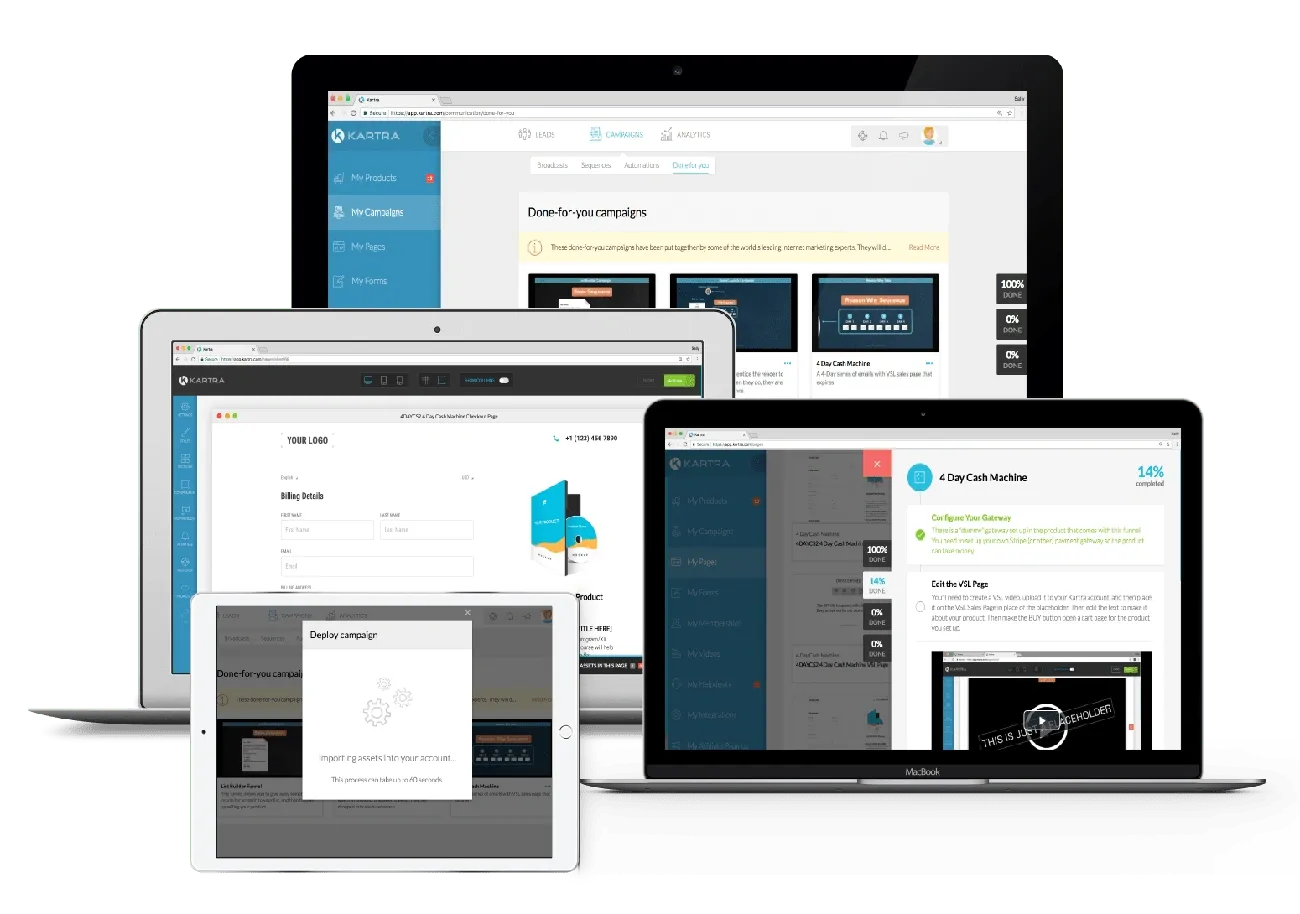
Image Source: Kartra
Kartra stands out as an all-in-one marketing platform that makes course creation a part of its business ecosystem. Entrepreneurs can build their online course business without piecing together multiple software programs [19].
Kartra key features
Kartra gives you reliable tools that go beyond simple course hosting:
- Complete business platform that combines 16+ features like landing pages, email marketing, video hosting, and membership sites [20]
- Drag-and-drop course builder with customizable elements to create engaging lesson pages [6]
- Advanced membership options that support unlimited courses and multiple payment structures [21]
- Built-in marketing tools with sales funnels, email automation, and affiliate management [22]
- Detailed analytics that track student engagement, completion rates, and subscription metrics [22]
The platform has unique features like in-course offers that let you upsell and cross-sell directly within lessons. You’ll also find a helpdesk feature to provide quick student support [6].
Kartra pros and cons
Pros:
- You won’t need multiple software subscriptions [4]
- Every paid plan comes with unlimited courses [6]
- No plan charges transaction fees [22]
- Strong automation capabilities for marketing sequences [3]
- All platform components blend together [4]
Cons:
- Users must click through multiple steps for navigation [6]
- New users face a learning curve [23]
- Costs more than simpler alternatives [24]
- Website and blogging features need improvement [4]
- Higher-tier plans restrict quiz and webinar features [6]
Kartra pricing
Kartra’s four pricing tiers come with annual billing discounts [25]:
- Starter: $99/month ($79/month annually) – 2,500 contacts, 15,000 emails/month
- Growth: $229/month (includes webinars and quiz features)
- Professional: $549/month for larger businesses
- Enterprise: Custom pricing for high-volume needs
Each plan comes with Kartra AI, but you’ll need higher-tier subscriptions for advanced tools [25].
Kartra best for
The platform works best for established entrepreneurs who want:
- A united tech stack without multiple platform integrations
- Detailed marketing automation with course delivery
- Multiple ways to monetize, including installment plans and trials [3]
- Complete funnel management from lead capture through purchase
Creators who prefer simplicity over extensive features might like Rupa Pro. Its AI Product Generator turns existing content into course outlines without technical complexity.
Stan Store
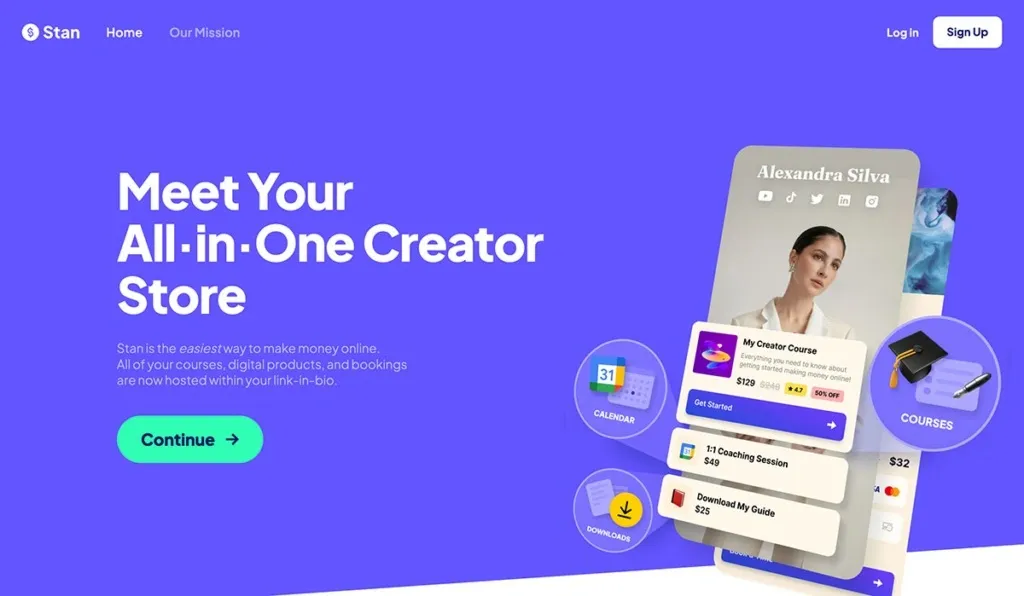
Image Source: Ecomm.design
Stan Store has become a game-changing digital product marketplace in just a few months. Creators can upload and sell their products without major investments [7]. The platform offers a creator-friendly solution that removes the complexity of technical setups.
Stan Store key features
Stan Store makes online selling simple and efficient:
- All-in-one solution that combines landing pages, checkouts, upsells, and email capabilities in one platform [7]
- Versatile product options supporting digital downloads, courses, coaching calls, and community spaces [26]
- Mobile-optimized storefront works as a professional “link-in-bio” store and feels like an extension of social media platforms [27]
- One-tap checkout system makes purchasing smooth for customers [26]
- Built-in video hosting eliminates the need for external hosting services [7]
Stan Store pros and cons
Pros:
- Easy-to-use interface that takes minimal setup time (around 15-17 minutes) [8]
- Zero transaction fees on all plans [27]
- Simple automated email features with welcome messages and sequences [7]
- Continuous connection with social media platforms for direct selling [28]
- Clean, distraction-free purchase experience [8]
Cons:
- Stan.store domain always shows up with no whitelabeling option [7]
- The $99/month plan locks several important features like email sequences and discount codes [7]
- Limited integration options (no direct Zoom integration in Europe) [7]
- Customization options are nowhere near what other strong platforms offer [7]
Stan Store pricing
Stan keeps pricing simple with two tiers:
- Creator Plan: $29/month or $300/year [29] You get a mobile-optimized store, calendar bookings, course builder, and analytics
- Creator Pro Plan: $99/month or $948/year [29] Adds email marketing flows, discount codes, upsells, affiliate links, and pixel tracking
Stan Store best for
Stan Store works best for a social-first creators who want a simple, hassle-free selling experience. Content creators, coaches, and digital product sellers can monetize their audience without dealing with technical complexities [30].
Rupa Pro’s AI Product Generator offers an even simpler alternative. It turns existing content into complete course outlines instantly, with no learning curve needed.
Teachable
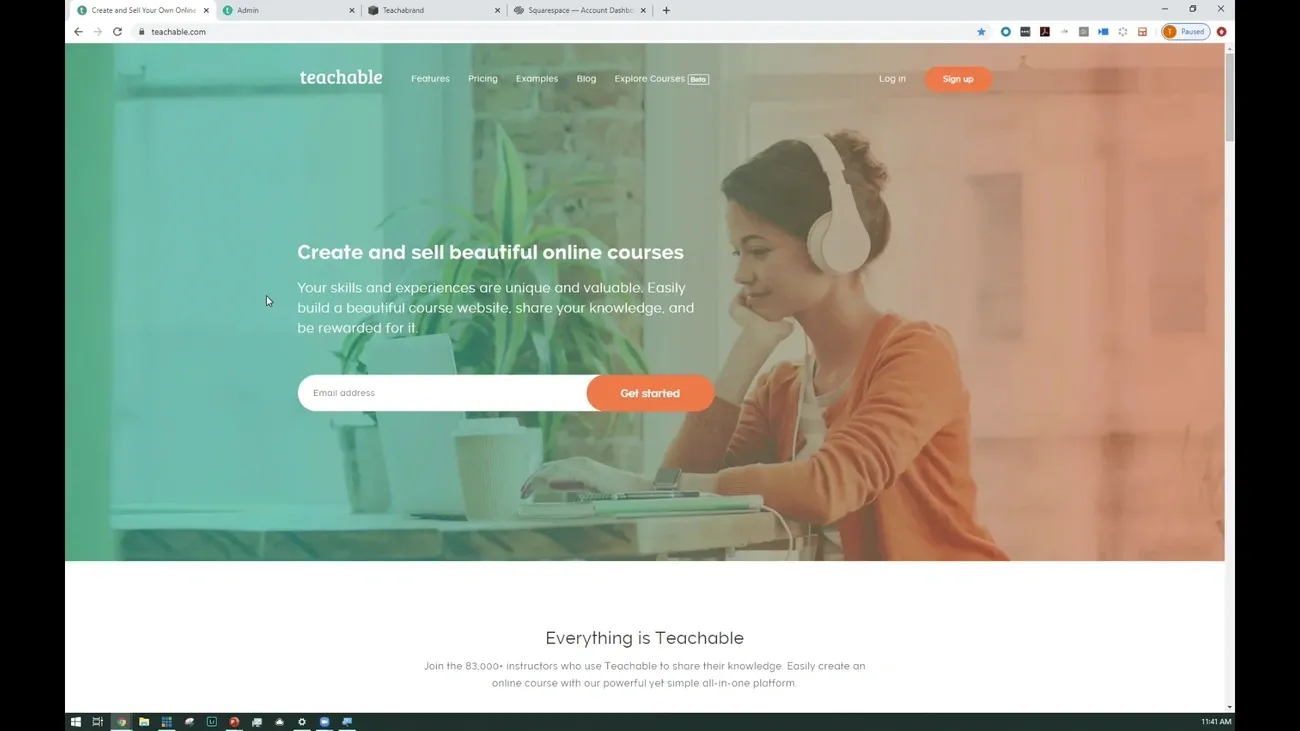
Image Source: Teachable
Teachable stands as an education-first platform that serves more than 150,000 creators. These creators have successfully sold over 30 million products to 32 million students worldwide [31]. The platform helps creators build their educational businesses from the ground up.
Teachable key features
The platform provides a complete set of tools for course creators:
- AI-powered assistance generates course outlines, quizzes, and translates subtitles automatically [9]
- Flexible product creation supports courses, digital downloads, coaching, communities, and memberships [31]
- Student engagement tools include auto-graded quizzes, certificates, and compliance features [13]
- Mobile learning comes through their top-rated iOS app (4.6 stars) with offline access [32]
- Global payments handle 120 currencies across 200+ countries with tax management [32]
Teachable pros and cons
Pros:
- Every plan includes unlimited product creation [11]
- Builder plan and higher tiers charge no transaction fees [13]
- User-friendly drag-and-drop course builder [32]
- Students enjoy great mobile experience [31]
- Marketing tools include upsells and abandoned cart recovery [9]
Cons:
- Starter plan charges 7.5% transaction fee [13]
- Product publishing has limits (1-100 based on plan) [13]
- Lower tiers restrict student numbers (100-1,000) [13]
- Higher pricing tiers gate advanced features [5]
- Backend loading sometimes faces issues [12]
Teachable pricing
Teachable’s 2025 pricing includes four main plans [13]:
- Starter: $29/month annually ($39/month monthly) with 7.5% transaction fee
- Builder: $69/month annually ($89/month monthly) with 0% transaction fee
- Growth: $139/month annually ($189/month monthly) with 0% transaction fee
- Advanced: $309/month annually ($399/month monthly) with 0% transaction fee
Teachable best for
The platform excels at serving creators who want professional course delivery without technical hassles. New course creators, scaling coaches, and experienced educators with various product offerings appreciate Teachable’s mix of simplicity and capability.
Notwithstanding that, creators seeking a more optimized approach can use Rupa Pro’s AI Product Generator to turn their existing content into course outlines without any technical learning curve.
Maven
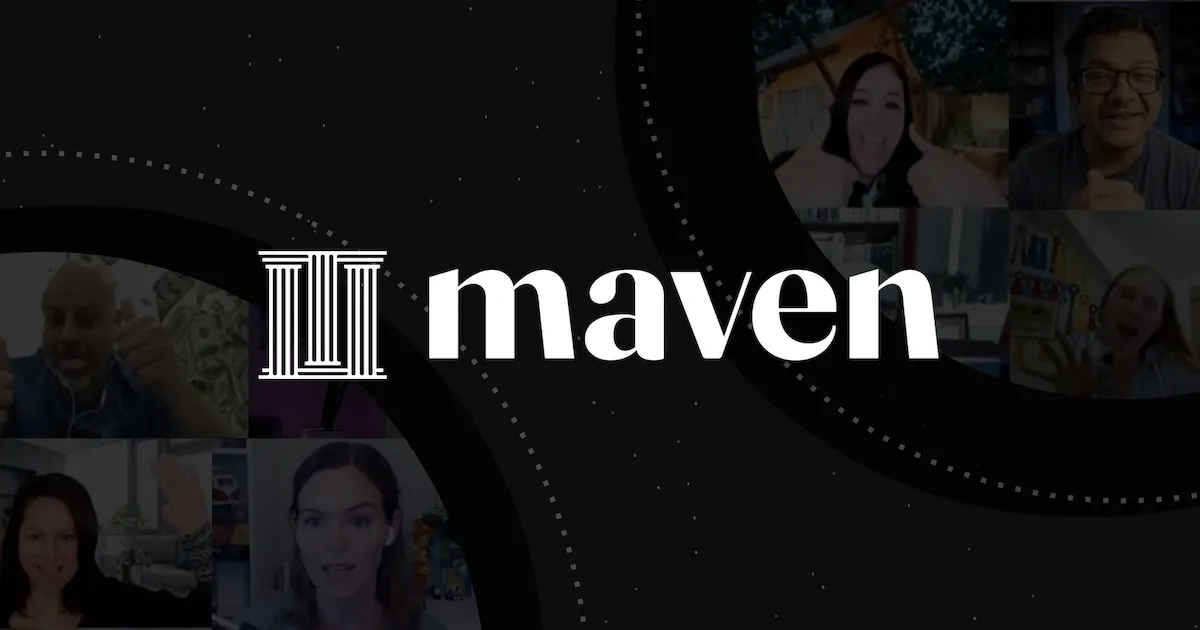
Image Source: maven.com
Maven helps elite professionals learn together in intensive, short courses. Instructors can earn over $20,000 per cohort [33]. This platform works great for experts who want to create premium educational experiences.
Maven key features
Maven stands out with these unique capabilities:
- Cohort-based learning model where classes run live for 2-4 weeks
- Live interaction emphasis that connects teachers directly with students
- Project-focused curriculum to drive ground application and participation
- High completion rates that exceed 75% compared to typical online courses [34]
- Premium positioning that draws professionals from Amazon, Google, Microsoft, Meta, and Shopify [35]
Maven pros and cons
Pros:
- Teachers gain high status in online education
- Students come from top professional backgrounds
- Course design can lead to substantial earnings
- Teachers keep their content and intellectual property [36]
- Well-laid-out cohort format builds accountability
Cons:
- Platform takes 10% of all sales [37]
- Premium focus means smaller potential audience
- Teachers must show deep expertise and stay involved
- Both sides need to commit substantial time
- Not as flexible as self-paced options
Maven pricing
Maven uses a simple revenue-sharing approach:
- Teachers keep 90% of course revenue (minus standard payment fees) [36]
- Creating courses costs nothing upfront [38]
- Courses usually cost between $800-$2500 [10]
- Prices reflect live teaching hours and project work [10]
Maven best for
Maven works best for experts who are teaching professional advancement skills. The platform shines when instructors share innovative skills with ambitious students who want to accelerate their careers. While it excels at premium courses, creators who want an easier way to build courses might prefer Rupa Pro’s AI Product Generator that turns existing content into complete outlines without technical hassles.
Comparison Table
| Platform | Starting Price (Monthly) | Transaction Fees | Key Features | Best For | Notable Pros | Notable Cons |
| Kajabi | $89 | Zero on all plans | – Course creation tools – Marketing suite – Website builder – Community management – AI-powered tools | – 5-year old content creators – Coaches selling high-ticket courses – Businesses needing advanced marketing | – Zero transaction fees – All-in-one solution – Built-in video hosting | – Higher starting price – Steep learning curve – Limited checkout customization |
| Thinkific | $36 | Zero on all plans | – Drag-and-drop course builder – Website builder – TCommerce selling – Student involvement tools – AI assistance | – Small-to-medium course creators – Businesses seeking customization – Education-focused organizations | – Accessible interface – Zero transaction fees – Excellent support | – Security concerns – Slow video uploads – No free plan |
| Podia | $39 | 5% on Mover plan 0% on Shaker plan | – Versatile product selling – Course builder – Website creation – Community tools – Email marketing | – Solo creators – Digital product sellers – Content creators | – Accessible interface – All-in-one solution – Excellent support | – Limited customization – No mobile app – Simple email features |
| Mighty Networks | $49 | 1-3% on all plans | – Dynamic member connections – Involvement tools – Space creation – Live streaming – AI Cohost | – Community builders – Membership site owners – Creators with large audiences | – Strong community tools – Native live streaming – Built-in referral program | – Complex interface – Transaction fees – Limited course features |
| LearnWorlds | $29 | $5 per course sale on Starter | – Interactive video engine – Assessment tools – Social learning – Content creation tools – SCORM compatibility | – Educational institutions – Businesses needing LMS – Interactive content creators | – Advanced video features – Complete assessment tools – White-label options | – Not beginner-friendly – Limited marketing tools – Steep learning curve |
| Kartra | $99 | Zero on all plans | – Complete business platform – Course builder – Membership options – Marketing tools – Analytics | – 3-year old entrepreneurs – Full-funnel marketers – Complete business needs | – No transaction fees – Unlimited courses – Powerful automation | – Complex navigation – High learning curve – Higher pricing |
| Stan Store | $29 | Zero on all plans | – All-in-one solution – Mobile storefront – One-tap checkout – Video hosting – Email capabilities | – A social-first creators – Digital product sellers – Content creators | – User-friendly – Zero transaction fees – Quick setup | – No whitelabeling – Limited features on simple plan – Limited customization |
| Teachable | $29 | 7.5% on Starter 0% on higher plans | – AI-powered assistance – Flexible products – Student involvement tools – Mobile learning – Global payments | – First-time creators – Coaches scaling up – 2-year old educators | – Unlimited products – Accessible builder – Mobile experience | – Basic plan fees – Student limits – Feature restrictions |
| Maven | Not mentioned | 10% on all sales | – Cohort-based learning – Live interaction – Project-focused curriculum – Premium positioning | – Elite professionals – Expert specialists – Career advancement focus | – Prestigious positioning – High completion rates – Instructor IP ownership | – High commission – Limited audience reach – Time intensive |
Conclusion
Your digital education business success depends on picking the right platform to sell your online courses. We’ve looked at nine leading platforms, and each one has something special to offer different creators. Kajabi has detailed marketing tools that set it apart. Thinkific lets you customize almost everything. Podia comes with a user-friendly design, while Mighty Networks excels at building communities. LearnWorlds gives you amazing interactive features, and Kartra provides a complete business system. Stan Store works great for social media creators. Teachable strikes a nice balance between simplicity and power. Maven specializes in premium cohort-based learning.
The best platform for you will depend on your goals, how tech-savvy you are, and your budget. Many creators find it hard to deal with complex course creation and marketing funnels that need lots of time and technical know-how. That’s why we keep mentioning Rupa Pro in our comparisons. Its AI Product Generator helps solve these problems by turning your existing content into complete course outlines quickly.
The online course market keeps growing faster than ever. You might feel overwhelmed by all these choices. The most important thing is to find a platform that matches your teaching style and business goals. Creators often spend too much time on technical setup instead of making great content. We suggest trying Rupa as the easiest way to create and launch your online course without getting stuck in technical details.
You can turn your expertise into steady income with these platforms, whether you’re new to course creation or a seasoned educator ready to grow. A trillion-dollar chance in online education is waiting for you – just pick the right platform and start your experience.
Key Takeaways
The online course industry presents a massive opportunity, with projections reaching $1 trillion by 2030, making platform selection crucial for success.
• Choose based on your needs: Kajabi excels for comprehensive marketing, Thinkific for customization, Podia for simplicity, and Mighty Networks for community building.
• Consider transaction fees carefully: Platforms like Kajabi and Thinkific offer zero transaction fees, while others charge 1-10% per sale, significantly impacting profits.
• Prioritize ease of use over features: Complex platforms with steep learning curves can delay your course launch and distract from content creation.
• Budget for growth: Starting prices range from $29-$99 monthly, but advanced features often require higher-tier plans costing $200-$400+ monthly.
• Focus on content creation, not technical complexity: Many successful creators waste time on platform setup instead of developing valuable educational content that drives sales.
The key to success isn’t finding the perfect platform—it’s choosing one that gets you started quickly so you can focus on creating courses that transform your expertise into sustainable income streams.
FAQs
Q1. What are the top platforms for selling online courses in 2025? Some of the best platforms for selling online courses in 2025 include Kajabi, Thinkific, Podia, Mighty Networks, and LearnWorlds. Each offers unique features suited for different creator needs and business models.
Q2. How do I choose the right platform for my online course? Consider factors like your budget, technical skills, desired features (e.g., marketing tools, community building), and target audience. Also, evaluate the platform’s pricing structure, customization options, and support services to find the best fit for your specific course and business goals.
Q3. What are the key features to look for in an online course platform? Important features include user-friendly course creation tools, flexible pricing options, marketing capabilities, student engagement features, analytics, and mobile compatibility. Some platforms also offer community-building tools and AI-powered assistance for content creation.
Q4. How much does it cost to use an online course platform? Pricing varies widely, with entry-level plans starting around $29-$99 per month. More advanced features and higher tiers can cost $200-$400+ monthly. Some platforms charge transaction fees, while others offer fee-free options on higher-priced plans.
Q5. Can I create and sell courses without a large existing audience? Yes, it’s possible to create and sell courses without a large existing audience. Some platforms like Udemy offer marketplaces to help you reach potential students. Alternatively, you can focus on building an email list, leveraging social media, and using the platform’s built-in marketing tools to grow your audience over time.
References
[1] – https://supplygem.com/learnworlds-pros-cons/
[2] – https://academy.learnworlds.com/
[3] – https://www.skylinesocial.com/kartra-review/
[4] – https://leydesignstudio.com/blog/kartra-review
[5] – https://elearningindustry.com/teachable-pricing-plans-costs-everything-you-need-to-know
[6] – https://supplygem.com/kartra-course-builder/
[7] – https://yourcoursecreationlab.com/blog/stan-review/
[8] – https://www.livingabstracts.com/what-is-stan-store/
[9] – https://teachable.com/features
[10] – https://help.maven.com/en/articles/6732396-pricing-your-course
[11] – https://teachable.com/pricing
[12] – https://www.capterra.ca/reviews/147019/teachable
[13] – https://support.teachable.com/hc/en-us/articles/36368677090573-New-Teachable-plans-in-June-2025
[14] – https://www.learnworlds.com/
[15] – https://www.learnworlds.com/plans/
[16] – https://support.learnworlds.com/support/solutions/articles/12000091813-learnworlds-user-experience
[17] – https://www.e-learningpartners.com/blog/my-5-favorite-learnworlds-features
[18] – https://www.learnworlds.com/pricing/
[19] – https://kartra.com/blog/everything-you-need-to-know-to-market-your-online-course/
[20] – https://www.saasgenius.com/reviews/kartra/
[21] – https://kartra.com/blog/creative-uses-kartra-membership/
[22] – https://kartra.com/feature/online-course-platform/
[23] – https://www.group.app/blog/what-is-kartra-pros-cons-frequently-asked-questions/
[24] – https://www.emailtooltester.com/en/blog/kartra-pricing/
[25] – https://kartra.com/plans-and-pricing/
[26] – https://www.stan.store/
[27] – https://www.creator-hero.com/blog/stan-store-pricing-and-review
[28] – https://funnelscene.com/stan-store-review/
[29] – https://help.stan.store/article/31-creator-vs-creator-pro
[30] – https://whop.com/blog/what-is-stan-store/
[31] – https://teachable.com/
[32] – https://teachable.com/online-courses
[33] – https://creatoreconomy.so/p/wes-kao-dos-donts-online-courses
[34] – https://a16z.com/announcement/investing-in-maven/
[35] – https://www.linkedin.com/posts/gaganbiyani_maven-courses-are-for-the-1-and-i-know-it-activity-7320496067035254784-qS8d
[36] – https://maven.com/resources/course-price-and-length
[37] – https://www.wp-tonic.com/best-udemy-alternatives-for-course-creators-in-2025/
[38] – https://medium.com/life-after-tech/top-10-cx-ux-reasons-to-not-put-a-course-on-maven-b58474cd59b3
